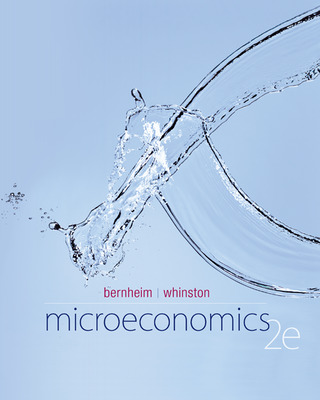
Microeconomics 2nd Edition by Douglas Bernheim
Edition 2ISBN: 978-0071287616
Microeconomics 2nd Edition by Douglas Bernheim
Edition 2ISBN: 978-0071287616 Exercise 2
The Smith and Jones families live next to each other. Each is planning to buy a car. We'll use S to stand for the amount the Smiths spend, and J for the amount the Joneses spend (both in thousands of dollars). The utility benefit the Smiths receive from their car is
 and the utility benefit the Joneses receive from theirs is
and the utility benefit the Joneses receive from theirs is
 Notice that both families care not only about the quality of the car they purchase, but also about how it compares to the other family's car. Spending more money on a car entails a utility cost, because it reduces the amount of other goods consumed. That cost is S 2 for the Smiths and J 2 for the Joneses. Suppose they choose S and J simultaneously. Find a Nash equilibrium in which both families spend the same amount on their cars. What is that amount Can they do better Would they be happier if both spent more than in the Nash equilibrium, or less
Notice that both families care not only about the quality of the car they purchase, but also about how it compares to the other family's car. Spending more money on a car entails a utility cost, because it reduces the amount of other goods consumed. That cost is S 2 for the Smiths and J 2 for the Joneses. Suppose they choose S and J simultaneously. Find a Nash equilibrium in which both families spend the same amount on their cars. What is that amount Can they do better Would they be happier if both spent more than in the Nash equilibrium, or less
 and the utility benefit the Joneses receive from theirs is
and the utility benefit the Joneses receive from theirs is  Notice that both families care not only about the quality of the car they purchase, but also about how it compares to the other family's car. Spending more money on a car entails a utility cost, because it reduces the amount of other goods consumed. That cost is S 2 for the Smiths and J 2 for the Joneses. Suppose they choose S and J simultaneously. Find a Nash equilibrium in which both families spend the same amount on their cars. What is that amount Can they do better Would they be happier if both spent more than in the Nash equilibrium, or less
Notice that both families care not only about the quality of the car they purchase, but also about how it compares to the other family's car. Spending more money on a car entails a utility cost, because it reduces the amount of other goods consumed. That cost is S 2 for the Smiths and J 2 for the Joneses. Suppose they choose S and J simultaneously. Find a Nash equilibrium in which both families spend the same amount on their cars. What is that amount Can they do better Would they be happier if both spent more than in the Nash equilibrium, or lessExplanation
Nash equilibrium:
The Nash equilibrium ...
Microeconomics 2nd Edition by Douglas Bernheim
Why don’t you like this exercise?
Other Minimum 8 character and maximum 255 character
Character 255


